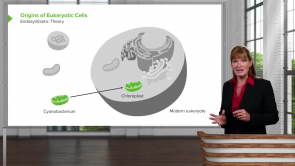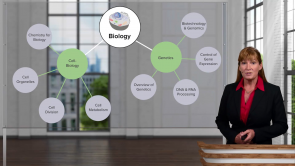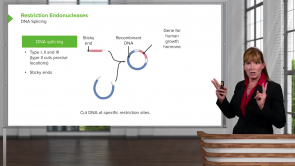CRISPR-Cas9 System

About the Lecture
The lecture CRISPR-Cas9 System by Georgina Cornwall, PhD is from the course Biotechnology.
Included Quiz Questions
Clustered regularly interspaced short palindromic repeats (CRISPR) are composed of which of the following?
- A family of DNA sequences containing pieces of DNA from invading viruses that attack the host bacterium
- A family of mRNA sequences containing pieces of mRNA from invading viruses that attack the host bacterium
- A family of signal protein sequences containing pieces of antigens from invading viruses that attack the host bacterium
- A family of signal lipoprotein sequences containing pieces of immunogenic proteins from invading viruses that attack the host bacterium
- A family of signal glycoprotein sequences containing pieces of immunogenic proteins from invading viruses that attack the host bacterium
Which of the following statements is NOT true regarding the CRISPR/Cas9 system?
- The CRISPR/Cas9 system helps in the amplification of viral DNA in host cells by providing adaptive immunity to the incoming virus.
- Viral snippets in the CRISPR of a bacterium play a crucial role in the bacterial defense system against bacteriophages.
- The pre-designed sequence of the guide RNA (gRNA) directs Cas9 nuclease to the right region of the invading DNA molecule such that Cas9 can cleave the foreign DNA.
- Cas9 nuclease cleaves double-stranded DNA at specific sites and activates DSB repair machinery in bacterial cells.
- The CRISPR/Cas9 system can be used as a targeted genome-editing tool in molecular biology.
Which of the following is true regarding the CRISPR/Cas9 system? Select all that apply.
- It is a very specific restriction endonuclease system derived from the bacterial "immune system."
- It is target-specific; thus, we can insert genes specifically as required.
- It shows potential for the future of DNA-based therapies.
- It was designed from scratch to eradicate type-2 diabetes.
- It is a eukaryotic endonuclease that can cut a gene as required.
These courses may be of interest to you
Customer reviews
5,0 of 5 stars
| 5 Stars |
|
5 |
| 4 Stars |
|
0 |
| 3 Stars |
|
0 |
| 2 Stars |
|
0 |
| 1 Star |
|
0 |










